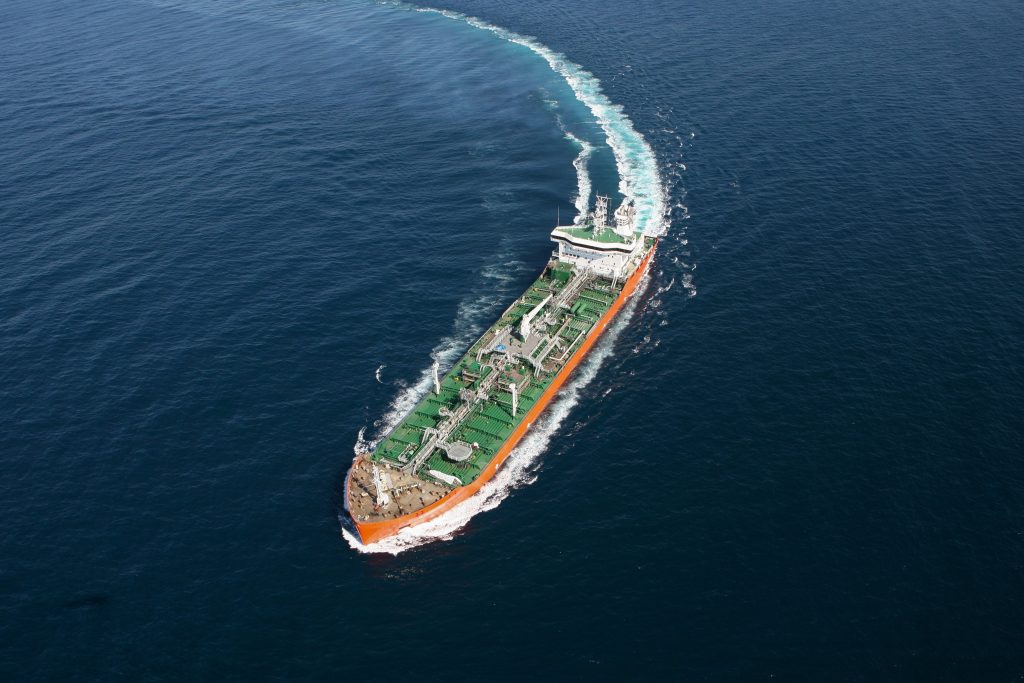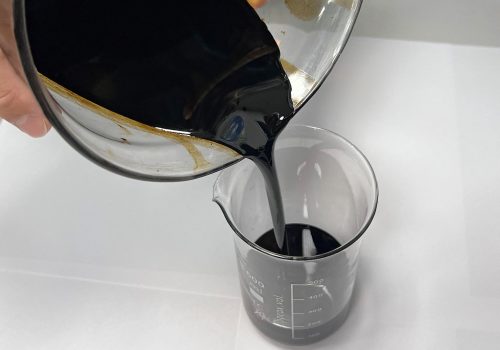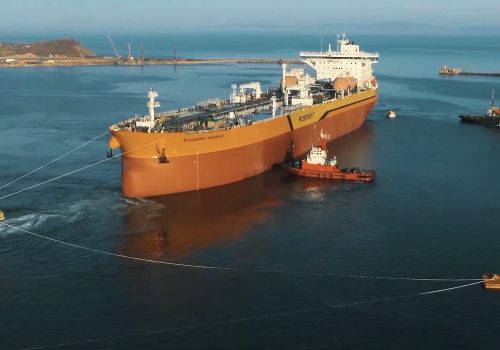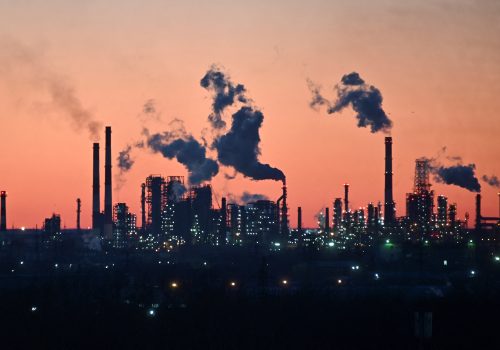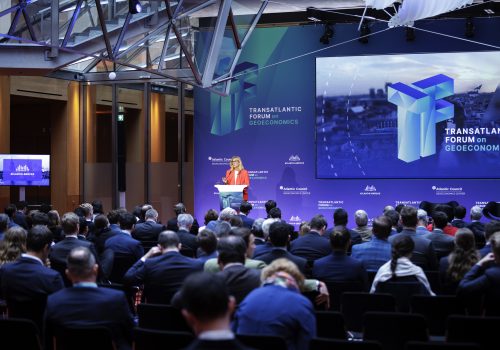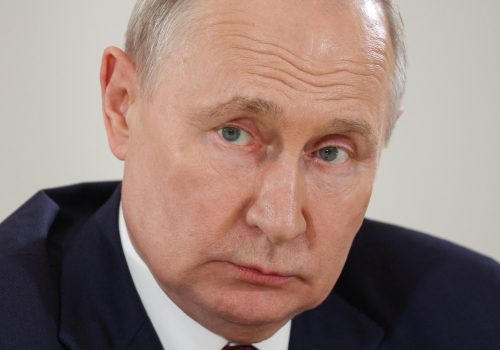The policy of capping the price of Russian oil exports reaches its first anniversary in less than a month. The idea was born just a few months after Russia launched its full-scale invasion of Ukraine, as the sanctions-wielding coalition identified record oil and gas export income as Moscow’s lifeline against an otherwise gloomy economic backdrop.
Most observers agree that the cap has played a role in limiting export income for Russia this year after a bumper 2022. Yet, as global prices have risen in recent months, the average price of an exported barrel of Russian oil has teetered above the sixty-dollar cap. September saw Russia’s monthly oil export earnings increase to $18.8 billion, the highest value since July 2022. A large fiscal deficit for 2023 seemed inevitable only a few months ago, but higher revenues captured through regular and special quarterly taxation mean Russia’s deficit may now be as small as 1 percent of gross domestic product or may even be replaced by a small surplus.
Alongside Western headlines on the price cap’s woes, Russian decision makers have become more brazen in their dismissal of the cap as a failure. In October, Deputy Prime Minister Alexander Novak called the cap “not only ineffective, but harmful” to Western consumers. In her long and technical briefing of the Russian Central Bank’s latest decision to raise interest rates, Central Bank Governor Elvira Nabiullina made a subtle dig by saying her forecasting teams would start using the Brent oil benchmark in their models instead of the Urals benchmark. It’s hard not to see a link to the price cap’s purported failure here. One of the reasons she gave for the switch was that it would allow the bank to better predict the Russian government’s tax take.
In June 2022, the Atlantic Council was among the first to showcase the nascent debate on the relative merits and risks of imposing a price cap. In the same format as the earlier article, experts offer several ideas on how the policy should be rebooted now. The three proposals below offer different views on how much can be expected of the cap, but all make useful policy recommendations on how to tighten implementation.
Keep the price cap as a cost to Russia without cutting off supply
The oil price cap mechanism always had a twofold goal: depressing Russia’s oil export revenues while keeping Russian supply on the market. Barrels sold by Russia have been systematically exceeding the sixty-dollar level prescribed by the cap in recent months as Brent has inched closer to one hundred dollars a barrel. But it’s still been possible to argue that the cap has dragged the average price of a Russian barrel down even as global prices have risen, thus depressing revenue for Moscow. Recent reports of significant tax revenues call more into question how long this argument can hold.
Beyond what the West needs to do to tighten obvious enforcement gaps, it also faces a communications problem. A slew of “the price cap isn’t working” headlines have hit front pages in recent weeks and months. It’s hard to disagree that the policy is failing to keep buyers of Russian barrels from paying above the sixty-dollar cap set in December of last year. But Western policymakers are more focused on how much harm Russia’s economy faces, suggesting that lens is better for evaluation than whether this complex price cap mechanism actually works.
Russia has lost more than $47.3 billion in income from oil exports since the price cap was introduced, according to estimates by the Atlantic Council’s GeoEconomics Center. This is over half of the $88.3 billion which Russia has made from exporting crude over the same period, according to customs data. This does not represent failure. The discount that Russian oil was already selling at compared to global prices has been entrenched by the cap. Even after the average price of a Russian barrel broke the cap in September, the discount to rising global prices has remained.
So far, the West’s attempts to tighten enforcement have been cautious, suggesting that the priority of keeping Russian oil on the market remains at least as important as limiting revenue. The first sanctions imposed by the US Treasury in relation to the price cap, imposed in October, were relatively low-profile, with only two new designations on firms based outside the coalition of countries that impose the cap. The justification provided is that the firms used US-based services—presumably insurance—for shipments that were not cap-compliant. US policymakers say this first attempt to sanction for cap circumvention is meant to serve as a deterrent and that a longer list of entities could be designated later. The European Union’s (EU’s) next package of sanctions—the twelfth—is expected to include measures against price cap circumvention too.
But as this all moves forward, those seeking to figure out what the West will do should pay less attention to the stories about whether a very complicated mechanism is “working.” Instead, they should focus on how policymakers are balancing between two priorities: keeping Russian oil on the market, and thus limiting price increases, while causing at least some impact on Russia’s income.
—Brian O’Toole is a nonresident senior fellow with the Atlantic Council’s GeoEconomics Center and global head of sanctions at Wells Fargo, where he oversees sanctions compliance and list-based screening efforts across the enterprise.
Take on the “shadow fleet” helping Russian oil avoid the cap
September marked a noticeable turning point for the oil price cap, as export income exceeded nine billion dollars for crude alone, according to calculations by the GeoEconomics Center. Russia has spent over a year and billions of dollars investing in a scrap-quality “shadow fleet” of oil tankers and seeking alternative insurance services. This has allowed it to shift 35 percent of its oil exports to providers based in jurisdictions that don’t apply the cap, while engaging in fraud—usually overinflated transport services and fake attestations—to sell oil above the sixty-dollar cap when using Western services for the other 65 percent. A multi-pronged approach is necessary to regain the lead in the sanctions game of cat and mouse. The sanctions-wielding coalition needs to improve transparency on the shadow fleet’s operations, strengthen attestation verification, and add a tariff to future ship sales to Russia by firms based in sanctions-wielding jurisdictions.
Russia’s recently acquired oil tankers play all the tricks in the book. Their ownership and management are opaque, with frequent “flag hopping,” or swapping a vessel’s flags to circumvent laws. The owners charge inconsistent freight rates with hidden trader and broker fees. Crew members spoof their vessel’s location or turn off their automatic identification system transponder, especially for ship-to-ship transfers (which are dangerous). The tankers are likely to exhibit severe maintenance deficiencies, too. The aged shadow fleet is a perfect recipe for an environmental disaster. For any ships passing through EU or UK territorial waters, authorities should mandate greater transparency and safety standards. Capitals that have decided against applying sanctions should also tighten supervision, if only to avoid an environmental disaster near their shores.
The foundation for this already exists in the eleventh sanctions package, which prohibits “access [to] EU ports for vessels that engage in ship-to-ship transfers suspected to be in breach of the Russian oil import ban or G7 [Group of Seven] Coalition price cap” and “for vessels which manipulate or turn off their navigation tracking system when transporting Russian oil subject to the oil import ban or G7 price cap.” This ban should be expanded to European territorial waters and not just the ports. Additionally, the ships should have up-to-date special survey inspections and be approved by a member of the International Association of Classification Societies Ships Registrations. Ships registered in countries with notoriously poor safety oversight, such as Cameroon, should also be banned from European territorial waters. Vessels moving through these areas should also showcase a clear and transparent ownership and management system, which will force greater accountability in case of an incident. And as suggested by former US Ambassador to Russia Michael McFaul’s International Working Group on Russian Sanctions, these ships should hold proper spill insurance.
How might all this help Ukraine and reduce Moscow’s revenues? Older ships are exceptionally expensive to maintain. Before Russia’s buying spree, ships more than fifteen years old were often worth more as metal scraps and parts. Moscow’s urgent and desperate need for alternative export methods has inflated their value. Forcing Russia to invest more into surveying and maintaining this fleet will reduce their net income and the amount they can devote to the war. For example, a special survey of one ship costs between three and four million dollars. Alongside the cost of longer shipping routes to reach Asian markets in lieu of European consumers and investments in launching insurance services, like-minded countries should use the cost of compliance to make it unviable for the shadow fleet to operate, forcing Russia to utilize reliable G7 services and sell its oil at cap-compliant prices.
There is an untapped space for cooperation between the West and the top buyers of Russian oil on ensuring the shadow fleet’s safety enforcements. China and India have already held back Russian ships for weeks due to safety concerns.
The G7 Coalition missed the boat on the first wave of shadow fleet acquisition by Russia, but something still can be done about future sales. European ship owners have made tidy profits by selling ships due for scrapping to Russia. All future sales should be taxed at a high level, but one where it still makes sense to pay the tax rather than to sell to Russia via circuitous measures and shell corporations. Though difficult to reach as new tax measures require the unanimous approval of member states, such a setup would protect European sellers while also making them more accountable for dealing with Russia.
—Olga Khakova is the deputy director for European energy security at the Atlantic Council’s Global Energy Center.
Go after refined products and dodgy attestations
As the one-year anniversary of the introduction of the Russian oil and petroleum products price cap in the EU approaches, this sanctions instrument is coming under increasing strain. With press reports of an ever-growing share of Russian oil trading outside the jurisdiction of the “price cap coalition” and many examples of Indian and Turkish petroleum products made from Russian crude entering the EU, it is fair to ask what the purpose of the policy is at this stage.
The European Commission will release its own proposals in the twelfth sanctions package next week, which are likely to require notification of tanker sales and banning trade with sanctioned vessels, as well as possibly some other measures. But three main problems are likely to remain unaddressed and they, too, require immediate attention.
The first one is a lack of review. The European Commission and the Council of Ministers have so far failed to review the level of the cap, though the legislation clearly sets out that the cap should be reviewed every two months. While the intention was to lower the cap, this could, in theory, have allowed the cap to be increased as long as it remained “at least 5 percent below the average market price for Russian oil and petroleum products.” But many member states still want to lower the cap, while others are closer to the United States in having Russian supply staying on the market as a priority. The lack of review remains puzzling, disheartening, and corrosive to the idea that EU law and compromises struck in the Council are followed. Although jurisdiction of the European Court of Justice on these matters is limited, one of the more hawkish EU member states could eventually try to sue the Council out of desperation and to highlight the problem.
The second problem is imports of petroleum products manufactured in third countries, such as India and Turkey, from Russian crude oil. Imports of petroleum products from countries that have clearly increased their imports of Russian crude as feedstock have increased. While the EU can hardly afford a complete ban on imports of petroleum products produced from Russian crude, it can afford to use the power of the EU import market to ensure full compliance with the price cap in line with the original spirit. Specifically, the EU should require that all imports into the EU of petroleum products manufactured from Russian crude abroad prove that Russian crude had been bought under the cap. This could be linked with a duty forcing third country refiners to log their imports of Russian crude to prove compliance. Opponents of this system will invoke complexity, but import procedures are already full of paperwork and documentation, which importers are used to dealing with. There is also the risk of fraud through false attestations, but that exists today. The system could work and any penalties should be high.
The third problem is the ease with which EU entities can claim to be complying with the cap, even if the underlying transactions they are engaged in do not. Under EU sanctions, EU insurance and shipping providers cannot service the export of Russian crude and petroleum, unless the transaction complies with the price cap. But the proof they are meant to demand varies. The EU’s guidelines have put actors into tiers depending on their access to pricing information. The closer one’s tier is to the underlying oil transaction, the more detailed the paperwork that is required to prove compliance.
For most, the documentation required is extremely light. Many entities can rely on generic attestations—often in the form of contract clauses—from other parties closer to the transaction stating they have complied or will comply in the future. This may partly be justified by the nature of the oil business: At the time the service provider is contracted, the price of the oil cargo is not yet known as the underlying transaction has not yet materialized. If increasing the burden of proof before the transaction is not an option, the new guidelines should at least require that EU entities verify—even ex post—the cargo was compliant with the cap once the transaction materialized. When billions of dollars are at stake, relying on parties’ promises to comply with the law is simply not good enough. The EU should not tolerate willful blindness when tens of thousands of innocent people are killed by weapons bought with money that EU companies helped Russia make.
Whatever the solution, the EU must do more to ensure the price cap is not routinely circumvented, as it seems to be today.
—Tomasz Wlostowski is a dual-trained EU/US sanctions lawyer with more than twenty years of experience in sanctions and export controls and the managing partner of EU Strategies, a consultancy.
Further reading
Fri, Sep 29, 2023
Five takeaways on the state of economic statecraft
New Atlanticist By Kimberly Donovan, Charles Lichfield
Sanctions and export controls have played a central role in the West’s response to Russia’s aggression against Ukraine, but there are other tools of economic statecraft, too.
Thu, Oct 26, 2023
Global Sanctions Dashboard: How Iran evades sanctions and finances terrorist organizations like Hamas
Econographics By
Iran’s financing of Hamas and other terrorist organizations; UAE’s role in facilitating Iran and Russia sanctions evasion; lifting of UN sanctions on Iran's ballistic missile program.
Fri, Sep 8, 2023
Five ways the West might increase pressure on the Russian economy
New Atlanticist By Brian O’Toole, Daniel Fried
The crumbling Russian macroeconomy may entice Western policymakers to knock Russian President Vladimir Putin and his power centers further off balance.
Image: A gasoline delivery of Russian energy company Rosneft in northernmost well of Russia.
